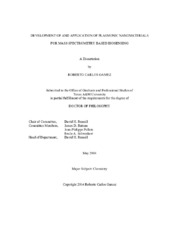| dc.description.abstract | The use of nanomaterials for sensing and biological applications has recently
gained interest owing to the unique physical, chemical and optical properties that arise
when materials are reduced to the nanoscale. The unique optical properties exhibited by
gold (Au) and silver (Ag) nanomaterials have made for versatile platforms in a wide
range of applications including surface plasmon biosensing techniques and laser
desorption/ionization mass spectrometry (LDI-MS). A primary driver for this work is the
relative ease performing surface modifications to nanoparticles (NPs), which can be used
to enhance the selectivity of ionization and/or facilitate analyte capture. The research
presented here focuses on the development of AuNP and AgNP based biosensors for
selective capture and ionization of low abundance compounds from complex mixtures
and subsequent detection by LDI-MS and Matrix Assisted Laser Desorption Ionization-
Mass Spectrometry (MALDI-MS).
First, a ‘strategy’ for selective capture and ionization of specific compound
classes based on chemical derivatization of gold nanorods (AuNRs) and infrared laser
desorption ionization (IR-LDI) is described. LDI is performed at near infrared
wavelengths (1064 nm) that overlap with the longitudinal surface plasmon resonance
(LSPR) mode of AuNRs which allows absorbed energy from the laser to facilitate the
desorption and ionization of the analyte. Capture of hydrophobic species using surfactant
coated AuNRs and subsequent detection by IR-LDI-MS was also demonstrated in these
experiments.
Second, the fabrication of a label-free MS and optical detection based biosensor
platform consisting of a phospholipid layer partially tethered to the surface of a gold
nanorod for the detection of low abundance lipophilic analytes from complex mixtures is
described. In these experiments, stable phospholipid capped AuNRs are produced by
tethering some of the phospholipids to the surface of the AuNRs though a covalent,
gold-thiol linkage. The effectiveness of the biosensor is demonstrated for the label-free
detection of a membrane active lipophilic drug from aqueous solution and of a
lipopeptide from fetal bovine serum.
Lastly, porous AgNP embedded thin films were fabricated by the sol-gel method
and utilized as matrix-free LDI-MS biosensors applicable to several chemical classes. In
these experiments, UV laser irradiation (337 nm) of the AgNP facilitates desorption and
ionization of a number of peptides, triglycerides, and phospholipids. Preferential
ionization of sterols from vesicles composed of olefinic phosphosphatidylcholines is also
demonstrated. | en |


